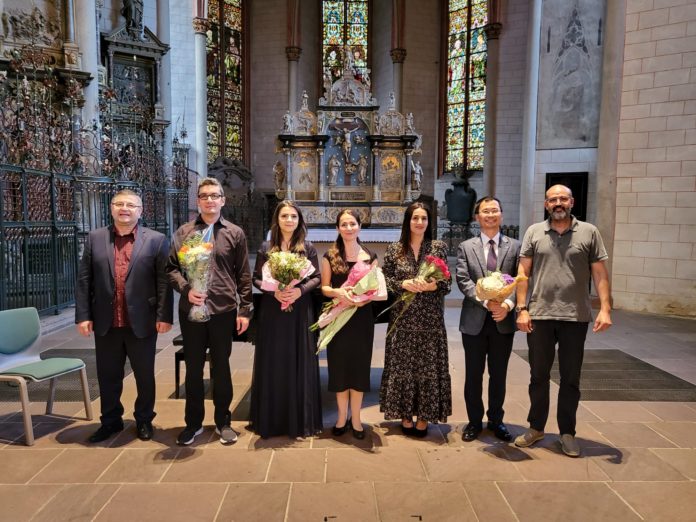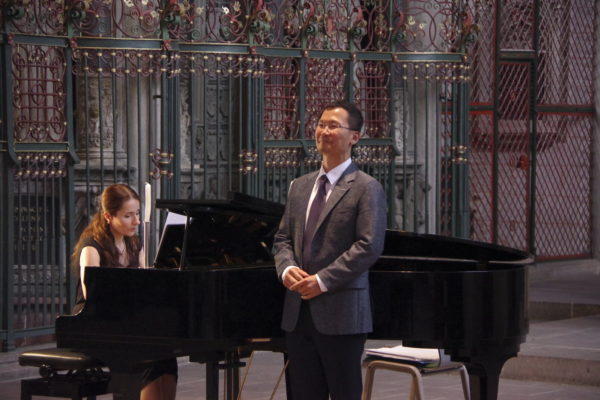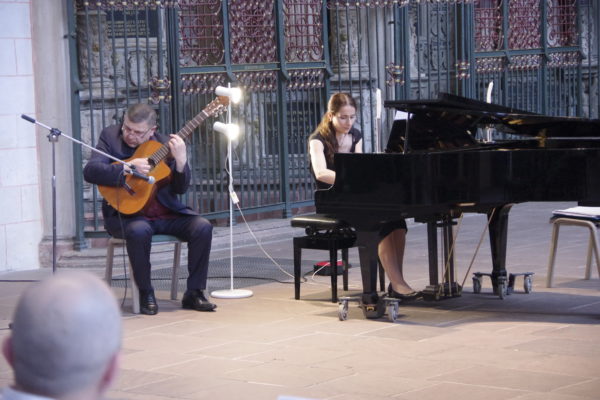
From left, Simon Manukyan, Ruben Gulkanyan, Maryam Manukyan, Amalia Safaryan, Seda Nahapetyan, Leo Jang and Abderrahim En-Nosse. (Photo by Norbert Kuche)
Artists Share the Joy of Music in Marburg
by Muriel Mirak-Weissbach
MARBURG, Germany, July 21, 2022 — What better way to welcome the summer than with music? What better way to enter summer in this troubled year than with a musical tribute to friendship across national borders? On June 17, a group of musicians gathered in the St. Marien Lutheran parish in historic Marburg, to present a selection of well-known pieces from many different cultures. The artists, mostly Armenian, performed works for voice, piano and string instruments to a large and very appreciative audience.
The idea for the concert came from Seda Nahapetyan, a young Armenian soprano who, after completing studies at the Yerevan conservatory, came to Germany, where she has continued her training and performed locally. It was months ago that the head of the Armenian parish in Giessen, where she lives, suggested that she and a pianist colleague, Amalia Safaryan, prepare some pieces for a commemorative event on April 24. Due to unforeseen developments, the event was cancelled, but the two performed for a small gathering the day before. That said, they had after all worked hard on a program, and wanted to bring it to fruition. They discussed the idea of reaching out to other musicians they knew, perhaps to organize another concert. Guitarist Simon Manukyan and violinist Ruben Gulkanyan agreed readily. Safaryan suggested calling the head of the St. Marien parish, where she had performed in a concert two years earlier, to ask if the church might be available. And he offered a date in June. After the first musicians had started practicing, Seda Nahapetyan invited Leo Jang, a baritone and teacher who had been giving her voice training, to stop by to listen in. He went, listened, was excited about the project and offered to join. One thing led to another, and before long, six musicians had come together, shaped a program, prepared a poster, invited friends and colleagues, and on June 17 they were ready.
“Sounds of the world, through lands and epochs” was the name they gave the concert. Abderrahim En-Nosse, a local teacher and friend of the organizers, greeted guests in the church, and explained that the idea was to engage in a musical voyage across continents and centuries.
Nahapetyan opened the program with Schubert’s Ave Maria, accompanied on the piano by Amalia Safaryan. The beloved piece, beautifully performed, set a tone of warm reverence and solemnity. Safaryan was to continue throughout the entire evening, displaying versatility in ensembles or accompanying vocalists, and virtuosity in works for piano. As a soloist she played Nocturne by A. Babajanyan, and Fantasie – Impromptu (Op. 66), Waltz in b minor (Op. 69 N. 2) and Nocturne in E-flat major (Op. 9 n. 2), by Chopin.
Nahapetyan later sang a second art song from the German repertoire, R. Schumann’s Widmung (Dedication), as well as Armenian pieces, R. Melikyan’s Vard (The Rose) and G. Chitchyan’s Aghavniner (The Doves), and Lauretta’s aria, O mio babbino caro, from Puccini’s opera, “Gianni Schicchi.”
The duets by pianist Safaryan and guitarist Simon Manukyan included Oblivion by Piazzola and Elegy by Babajanyan. Daughter Mariam Manukyan and Ruben Gulkanyan, both violinists, formed a trio with Safaryan to perform a Prelude as well as an Elegy by Shostakovitch. And in two violin-piano duets, Gulkanyan joined Safaryan to perform Thaïs: Méditation by J. Massenet and Cantabile by N. Paganini.

Leo Jang and Amalia Safaryan (Photo by Norbert Kuche)
The second vocalist was baritone Leo Jang, originally from South Korea, who sang two pieces by Schubert, Im Frühling (In Springtime) and An die Musik (To Music). The grand finale featured Jang and Nahapetyan, accompanied by violinists Gulkanyan and pianist Safaryan in a lively rendering — in song and dance — of the famous Lippen Schweigen (Lips are silent), from F. Léhar’s operetta, “The Merry Widow.” The audience, made up of friends, relatives, members of the community, but also foreign tourists, responded with unbridled enthusiasm and joy.
What made the concert so wonderful was not only the excellent acoustics in this historic church, whose original Romanesque structure dates back to the 13th century; nor was it only the program, which indeed offered such musical and cultural diversity. What was most striking and moving was to realize that the musicians, who combined talent and accomplishment, are both professionals and amateurs, working as a team. As indicated, they came together around the project, motivated not by profit or career, but solely through friendship and the shared love for music.
Most of the performers are Armenian. Like Seda Nahapetyan, pianist Safaryan also comes from Armenia, and studied at the Conservatory in Yerevan before moving to Germany. A mother of four children, she teaches piano in a school in Marburg.
Simon Manukyan and Mariam Manukyan are father and daughter. Employed as a bookkeeper, Mariam played violin as a child and was delighted to be invited to join the other musicians for the concert. Her father Simon studied guitar in Yerevan, where he played with several bands. Given the financial difficulties many musicians face, he sought and found other employment, but continues to perform whenever possible.

Simon Manukyan and Amalia Safaryan (Photo by Norbert Kuche)
Foremost among the professionals in the group is Leo Jang. Originally from South Korea, this extremely gifted singer studied in Seoul and later in Cologne, Germany. He performed for several years as a soloist in the Stralsund Theater before joining the Giessen City Theater, where he sings in the chorus. Violinist Ruben Gulkanyan, who studied in Armenia as well as Nürnberg, plays in the orchestra of the same theater in Giessen.
There was no entrance fee for the concert, so participants showed their appreciation with flowers—many more bouquets than there were musicians – as well as spontaneous donations, certainly intended to defray the costs of the next concert.